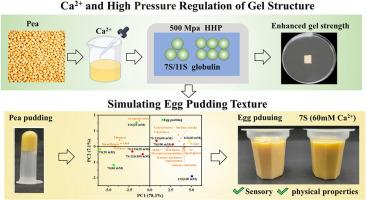Calcium and high pressure regulation of 7S/11S pea globulin gel structure for simulating egg pudding texture
IF 11
1区 农林科学
Q1 CHEMISTRY, APPLIED
引用次数: 0
Abstract
Pea globulins demonstrate promising gelation properties as potential alternatives to animal-derived proteins. When subjected to high hydrostatic pressure (HHP) treatment at 500 MPa, pea 7S and 11S globulins exhibit weakened structural integrity conducive to forming soft gel matrices analogous to commercial egg-based products. To optimize textural attributes and sensory profiles, this study employed a combined approach of high-pressure treatment (500 MPa) and calcium ions (Ca2+, 5–20 mM) for precise modulation of gel characteristics. A comprehensive evaluation framework incorporating rheological analysis, textural profiling, water holding capacity (WHC) assessment, and scanning electron microscopy (SEM) was employed to characterize gel properties. Small-angle X-ray scattering (SAXS) elucidated the underlying gelation mechanisms. Principal component analysis (PCA) identified optimal formulations demonstrating physical and sensory congruence with conventional egg pudding. Experimental results revealed concentration-dependent enhancement of gel properties with Ca2+ supplementation. Rheologically, Ca2+ induced 13.6- to 86-fold increases in storage modulus (G′ at 1 rad/s) compared to control samples. Textural parameters exhibited broad modulatory ranges: hardness (0.25–1.21 N), chewiness (0.15–1.27 mJ), cohesiveness (0.32–0.86), and springiness (1.88–0.87 mm). WHC demonstrated calcium-responsive variability between 75 % and 100 %. Microstructural analysis revealed Ca2+-mediated alterations in aggregate dimensions and network density. Notably, the 7S pea pudding with 60 mM Ca2+ optimization achieved exceptional congruence with egg pudding benchmarks in organoleptic and physical properties, while exhibiting superior structural integrity (cohesiveness: 1.26 ± 0.05) and reduced surface fracturing. This investigation establishes a theoretical foundation for developing plant-based analogues with animal product equivalency, particularly in soft gel food applications.

模拟蛋布丁质地的7S/11S豌豆球蛋白凝胶结构的钙和高压调控
豌豆球蛋白作为动物源性蛋白的潜在替代品,具有良好的凝胶特性。当受到500 MPa的高静水压力(HHP)处理时,豌豆7S和11S球蛋白表现出较弱的结构完整性,有利于形成类似于商业蛋基产品的软凝胶基质。为了优化凝胶的纹理属性和感官特征,本研究采用高压处理(500 MPa)和钙离子(Ca2+, 5-20 mM)相结合的方法来精确调节凝胶的特性。采用综合评估框架,包括流变分析、结构分析、持水能力(WHC)评估和扫描电子显微镜(SEM)来表征凝胶性质。小角x射线散射(SAXS)阐明了潜在的凝胶机制。主成分分析(PCA)确定了与传统鸡蛋布丁在物理和感官上一致的最佳配方。实验结果显示,钙离子的浓度依赖性增强凝胶性能。流变学上,与对照样品相比,Ca2+诱导的存储模量(G ' at 1 rad/s)增加了13.6- 86倍。质地参数具有较宽的调节范围:硬度(0.25-1.21 N)、耐嚼性(0.15-1.27 mJ)、黏结性(0.32-0.86)和弹性(1.88-0.87 mm)。WHC显示钙响应变异性在75%到100%之间。微观结构分析显示Ca2+介导的聚集体尺寸和网络密度的改变。值得注意的是,60mm Ca2+优化后的7S豌豆布丁在感官和物理性质上与鸡蛋布丁的基准非常一致,同时表现出优越的结构完整性(黏结性:1.26±0.05)和减少表面断裂。该研究为开发具有动物产品等效性的植物性类似物奠定了理论基础,特别是在软凝胶食品应用中。
本文章由计算机程序翻译,如有差异,请以英文原文为准。
求助全文
约1分钟内获得全文
求助全文
来源期刊

Food Hydrocolloids
工程技术-食品科技
CiteScore
19.90
自引率
14.00%
发文量
871
审稿时长
37 days
期刊介绍:
Food Hydrocolloids publishes original and innovative research focused on the characterization, functional properties, and applications of hydrocolloid materials used in food products. These hydrocolloids, defined as polysaccharides and proteins of commercial importance, are added to control aspects such as texture, stability, rheology, and sensory properties. The research's primary emphasis should be on the hydrocolloids themselves, with thorough descriptions of their source, nature, and physicochemical characteristics. Manuscripts are expected to clearly outline specific aims and objectives, include a fundamental discussion of research findings at the molecular level, and address the significance of the results. Studies on hydrocolloids in complex formulations should concentrate on their overall properties and mechanisms of action, while simple formulation development studies may not be considered for publication.
The main areas of interest are:
-Chemical and physicochemical characterisation
Thermal properties including glass transitions and conformational changes-
Rheological properties including viscosity, viscoelastic properties and gelation behaviour-
The influence on organoleptic properties-
Interfacial properties including stabilisation of dispersions, emulsions and foams-
Film forming properties with application to edible films and active packaging-
Encapsulation and controlled release of active compounds-
The influence on health including their role as dietary fibre-
Manipulation of hydrocolloid structure and functionality through chemical, biochemical and physical processes-
New hydrocolloids and hydrocolloid sources of commercial potential.
The Journal also publishes Review articles that provide an overview of the latest developments in topics of specific interest to researchers in this field of activity.
 求助内容:
求助内容: 应助结果提醒方式:
应助结果提醒方式:


